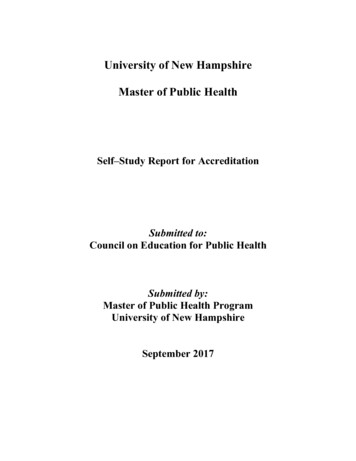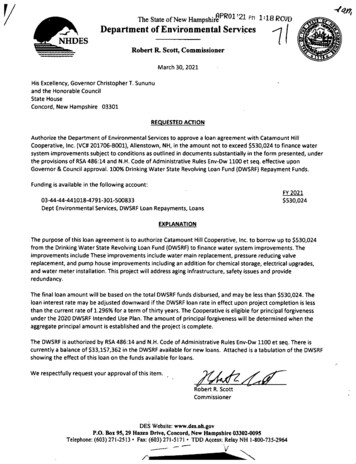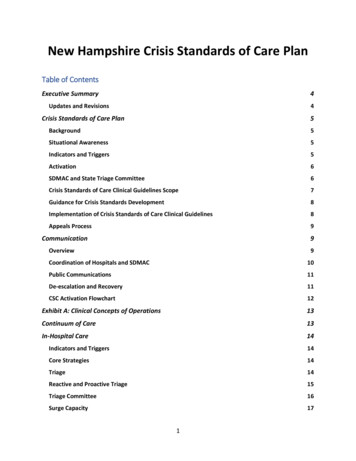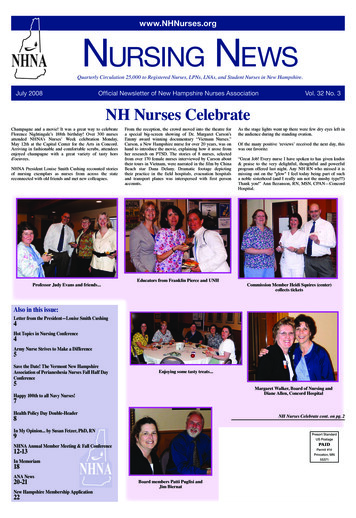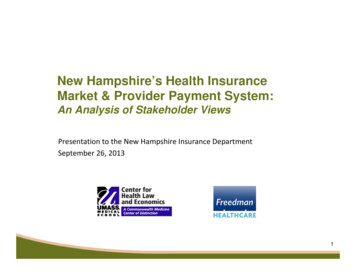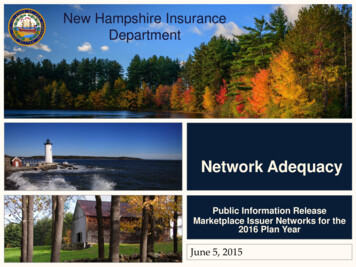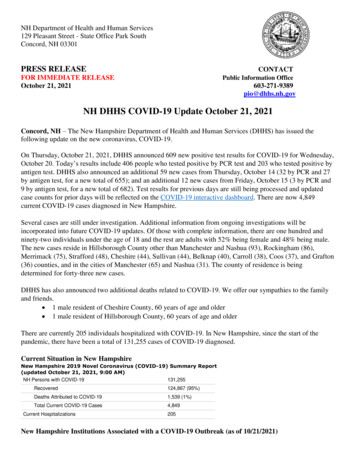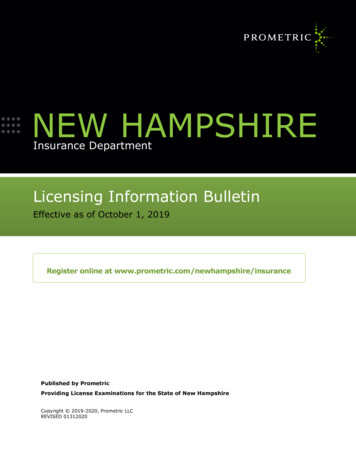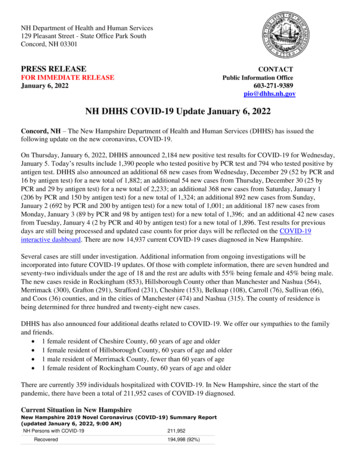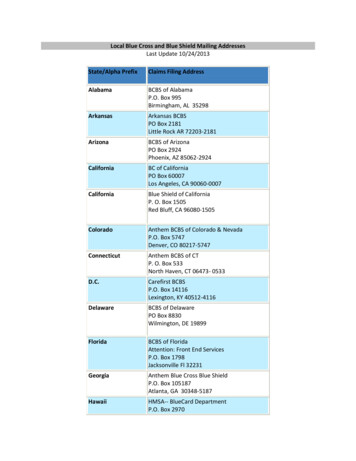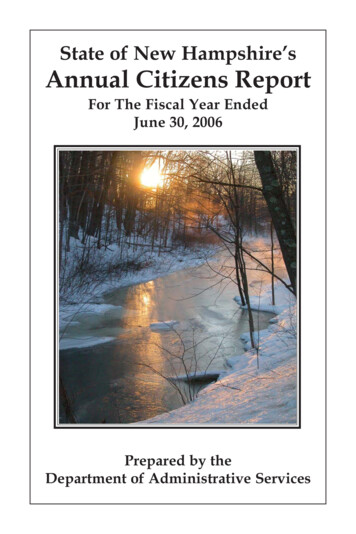
Transcription
State of New Hampshire’sAnnual Citizens ReportFor The Fiscal Year EndedJune 30, 2006Prepared by theDepartment of Administrative Services
1Table of ContentsState r'sMessage.Economic.Major Initiatives.Self-Insurance.Education.23456789State of New Hampshire’sAnnual Citizens ReportFor Fiscal Year EndedJune 30, 2006Health & HumanServices.10-11Public Works. 12Debt . 13Financials. 14-20Department ofAdministrative Services25 Capitol StreetState House AnnexRoom 310Concord, NH 03301(603) d by the Department ofAdministrative ServicesDonald S. Hill, CommissionerDivision of Accounting ServicesSheri L. Rockburn, ComptrollerStephen C. Smith, DirectorDiana L. SmestadKelly J. Brown
2State OfficialsPhoto(L-R) Back: Commissioner Hill, Councilor Spaulding.Front: Councilor Wieczorek, Councilor Griffin, Governor Lynch,Councilor Burton, Councilor Pignatelli.Selected State Officials as of June 30, 2006:GovernorJohn H. LynchExecutive CouncilRaymond S. Burton, District 1Peter J. Spaulding, District 2Ruth L. Griffin, District 3Raymond J. Wieczorek, District 4Debora B. Pignatelli, District 5President of the SenateTheodore L. Gatsas24 SenatorsSpeaker of the House of RepresentativesW. Douglas Scamman Jr.400 Representatives
Message From the GovernorTO:3The Citizens of the State of New Hampshireand the Honorable Members of the LegislatureI am pleased to accept the Fiscal Year 2006 State of New Hampshire Annual Report to the Citizens.We live in the greatest state in the greatest country in the world, and I am committed tocontinuing to work with all the people of New Hampshire to keep it that way. We continueto come together in Concord – Democrats and Republicans – to put aside partisanship andfocus on getting good results for the people of New Hampshire. Together, we balanced thestate’s budget, worked to conduct state government’s business efficiently and effectively, andto make smart investments in New Hampshire’s future and people, including providingurgent assistant to communities and people hit hard by flooding and to seniors struggling toget their medications under the new federal prescription drug law.During the past year, we made significant progress on issues important to New Hampshireand its citizens: We put 51.7 million in the state’s Rainy Day Fund to help ensure our future fiscalstability. We provided critical assistance to families hardest-hit by severe flooding so that theycould recover from the devastation. We acted to make sure seniors could still get their medications after problems with thenew federal prescription drug law prevented some from getting their prescriptionsfilled. We ensured college students with life-threatening illnesses would not lose their healthinsurance just when they needed it most. We put in place a strong, new ethics law, creating the first-ever ethics commission forthe Executive Branch. We committed to preserving the public’s safety, passing one of the toughest and mostcomprehensive laws in the country to protect children from sexual predators, makingimportant licensing information regarding childcare centers more accessible, andtoughening existing penalties for producers of methamphetamine. We acted to preserve and protect the natural resources and beauty that make NewHampshire such a great place to live and work, implementing legislation significantlyreducing mercury, putting a moratorium on the burning of toxic construction anddemolition debris in the state and leading by example by working to make stategovernment more energy efficient.I am very proud of all we have accomplished in the past year. I would like to take thisopportunity to thank you for your support, and to thank our great state employees for alltheir hard work and dedication. Without their efforts, and without the support andinvolvement of people from across New Hampshire, much of the progress we have madewould not have been possible.Sincerely,John H. LynchGovernor
4New Hampshire’s ScoreboardNew Hampshire’s Economic Scoreboard for 2006NH’sNH’s RankNationalin NewRankEnglandCategoriesFavorable Tax ClimateHealthiest State (M organ Quitno,2006)Standard of Living (by PovertyRate)Child and Family Well-Being(Annie E. Casey, 2005)Safest State (Lowest crime rate,2004)M ost Livable State (M organQuitno, 2006)College Educated 2ndew Hampshire has continued to receive high qualityof life rankings in Morgan Quitno’s Most LivableState Awards, ranking first in standard of living, familywell being, and the most livable state.
Message From the Commissioner5We would like to present our fiscal year 2006 Annual Report to the Citizens, prepared bythe Department of Administrative Services. It is our hope that this report providesan overview of the state’s core finances in a format that is useful and informative to thecitizens of New Hampshire.This report presents selected financial information for the state’s general fund and educationtrust fund, including unrestricted revenue performance and a surplus statement, andfinancial information on a government-wide basis, in accordance with generally acceptedaccounting principles (GAAP). Readers that have a need for more information regardingthe accounting policies, the various required accouting disclosures, and the financial statusof individual state funds and component units, should obtain a copy of the state’sComprehensive Annual Financial Report (CAFR). The CAFR, which includes theindependent auditors’ report, can be accessed by viewing our website or by contacting theDepartment.New Hampshire continued to experience economic growth during the year despite theslowdown in the housing market during the latter half of fiscal 2006. New Hampshire’sdiversified tax structure, with its reliance on business enterprise taxes and the statewideproperty tax, have added stability to our revenue streams as compared to other states,which rely heavily on income tax proceeds. During 2006, the state’s unrestricted revenuewas 55.7 million or 2.6% ahead of plan. The major contributor to this growth was strongcollections from Business Taxes which included one-time collections related to therepatriation of foreign earnings.The combined General and Education Fund Balances at the start of the fiscal year totaled 82.2 million. Lawmakers included 30.5 million of the surplus to help balance the fiscal2006-07 biennial budget and, during fiscal 2006, directed the remaining 51.7 million betransferred to the Rainy Day Account, bringing the balance in the Rainy Day Account to 69.0 million at June 30, 2006.After the Rainy Day transfer, the combined General and Education Fund balance atJune 30, 2006 was 34.4 million, largely the result of revenue collections exceedingestimates during the year.Donald S. Hill, Commissioner
6Economic Highlights of the Granite StateNew Hampshire’s economy is expected to continue to grow, but at a somewhat slower rate ofgrowth than that experienced during the first half of this decade. The state continues to experienceone of the strongest growth rates in population and employment in New England. Per capitaincome levels are rising and poverty rates remain one of the lowest in the nation. The state hasretained its advantages over other states in the region with low unemployment, low tax burdens,highly educated and skilled workforce, and a small and accessible government.New Hampshire has continued to receive high quality of life rankings in Morgan Quitno’sMost Livable State Awards, ranking first in standard of living, family well being, and the mostlivable state.% Change in total employmenPersonal income levels continued to rise with a 6.6% increase for the year ending June 2006.New Hampshire’s employmentEmployment Changegrowth is expected to be slightly below1990-0125.0%22.7%the national average over the next few2001-0219.4%years. However, through 2010, New20.0%2003-04Hampshire is forecasted to be the only15.0%Projected12.3%New England State with employment2005-10NH 1.2%10.0%growth greater than 1%. In addition,US 1.3%NE 0.8%New Hampshire is forecasted to be5.0%1.5%1.2%0.8%above regional growth averages in all0.0%major employment t manufacturing. Granite Statemanufacturing jobs declined at a 5.0%annual rate during the period 2000-2005. Going forward, this rate of decline is forecasted toslow to a 1.2% average loss per year. As of June 2006, New Hampshire’s seasonally adjustedtotal nonfarm employment grew by 0.3% from June of last year, and the state’s unemploymentrate was 3.3%, which continues to track lower than New England (4.5%) and the nationalaverage (4.6%).Avg annual % changeOne of the strongest sectors of the New Hampshire economy since the mid 1990’s is now showingundeniable signs of slowing andperhaps even contraction. ResidentialChange in Median Housing Pricehousing, which has put billions of1999-20042004-2009dollars into consumer pocketbooks12%11%through sales of new and existing10%10%homes, refinancing and home equity8%7%loans, has begun to correct. New5%6%Hampshire’s housing sector is4%4%expected to have a “soft landing” with4%a modest decline in housing prices2%followed by slight growth in prices0%through 2010. New Hampshire’sUSNENHmedian home price is forecasted toincrease at an annual rate of about half the US average.Economists caution, however, that economic forcasts could have a relatively high downside potentialas influenced by uncertainty in the housing market. A weaker and longer to recover housing marketwould have negative influence on the regional economy, including New Hampshire. Some recessionrisks will remain elevated as long as the housing correction continues to unfold.Information Provided by New England Economic Partnership, Ross Gittell and James R. CarterProfessor, Whittemore School of Business and Economics, University of New Hampshire.
Major Initiatives7Enterprise Resource Planning (ERP)Enterprise Resource Planning (ERP) is an information technology industry term forintegrated, multi-module application software packages designed to serve and supportseveral business functions across an organization. An ERP system is a strategic tool thathelps the organization improve operations and management by integrating businessprocesses and helping to optimize the allocation of available resources. These systems aretypically commercial software packages that facilitate collection and integration ofinformation related to various areas of an organization such as finance, accounting, humanresources, inventory, procurement, and customer service.The 2005 capital budget included 19.0 million of appropriations for the ERP project ofwhich 5.5 million has been spent to date. In April 2006, a vendor was selected and Ciber,Inc. and Lawson Software were awarded contracts and on July 26, 2006 the ERP projectwas officially kicked off under the project name of NH FIRST (New HampshireFundamental Improvements to Revitalize Systems/Services and Technology).NH FIRST will be replacing the state’s separate and antiquated budgeting, accounting andhuman resources systems with a new, fully integrated system, which will offer far morefunctionality than exists today and will support statewide business office functions. NHFIRST will use the latest information technology to allow information sharing with otheragencies, vendors, and citizens like never before and will transform the way NewHampshire state government does business.NH FIRST will be implemented using a multi-phase approach over a 2-1/2 year span withthe first phase due to go live during fiscal year 2008.E-ZPassThe first year of E-ZPass electronic tolling on the New Hampshire Turnpike Systemsaw consistent growth in the number of users and positive results in improving trafficflow. The total number of E-ZPass accounts in FY 2006 was approximately 168,000, withthe total number of transponders sold totaling approximately 295,000. As of June 30, 2006,the E-ZPass market share was at 40%. The conversion of the entire toll collection system toE-ZPass was completed in August 2005 at the Bedford Toll, Hooksett Main and HooksettRamp, FE Everett Turnpike, Hampton, and Spaulding Turnpike. In September 2005,commercial charge card accounts from approximately 3,000 customers were phased out.Tokens ceased to be accepted for payment of tolls on December 31, 2005. A 30% discountis now applied to all New Hampshire based E-ZPass private accounts, and a 10% discountis applied to all New Hampshire based business accounts. This combined change in thediscount program has contributed to revenues increasing by approximately 21% overFY 2005.
8Self - Insurance InitiativeEmployee Benefit Risk Management FundChapter 251, Laws of 2001, authorized the Commissioner of Administrative Services toprovide a self-funded alternative to traditional insurance programs for employeebenefits to aid in controlling the rise in insurance costs. As a result, a new fund, titled theEmployee Benefit Risk Management Fund, was established beginning in October 2003.The fund was created to manage the state’s self-insurance program and to pool all resourcesto pay for the cost associated with providing employee health benefits for active stateemployees and retirees. Agencies are charged an actuarially determined contribution tobe paid into this new fund on a bi-weekly basis. These contributions are intended to coverthe costs of claims presented, stop-loss coverage, administrative fees and reserverequirements. Claims payments by the third party administrator to the providers arereimbursed by the state daily out of this new fund.The state is currently analyzing the first twenty-one months of activity in this fund. Thestate has contracted with a consulting firm to assist and provide actuarial, claims auditand general consulting services in order to evaluate the performance of this fund and todetermine the best way to control health benefit costs through this arrangement.At June 30, 2006, the fund ended the year with a surplus of 21.4 million and cash on handof 38.0 million.He alt h In s u r an ce C o s t sPr e m iu m s /C laim s PaidA ctive an d Re tir e d Em p lo ye e sMillions25% 210 180 12015% 9010% 605% 300% 0001020304Fis cal Ye ar050600-03 Repr es ents premiums paid to ins uranc e c arr iers04- 06 Repres ents c laims paid under new s elf ins uranc e plan% ChangeMedical Costs20% 150
EducationGeneral Fund Support for Education(In Millions)Community Tech CollegesThe Department has dispersed over 250 millionPostsecondary Ed Commdollars in federal aid to local districts to supportDept of Education 300USNH9student learning. In addition, during the 2006 250school year, state aid for local schools districts 200was allocated in the following ways: (1) Adequate 150Education Grants 836.2 million; (2) Building 100Aid 37.8 million; (3) Catastrophic Aid 28.0 50million; (4) Tuition and Transportation for Careerand Technical Programs 5.1 million; and (5) 20022003200420052006Kindergarten Aid 567,600.The Department of Education continues its commitment to defining the state’s standardsof measurement of school progress. During the 2006 school year 836 million dollarswas appropriated for adequate education grants to local schools and was paid out of thestate’s Education Trust Fund.The Department promotes the Follow The Child Initiative, which calls for a personalizededucation for each child in New Hampshire. This initiative documents the progress ofevery student, using multiple measures of assessment, personally, physically, socially,and academically. To this end, the Department has submitted an application to the UnitedStates Department of Education that will allow for the use of growth targets towardacademic proficiency for each NH child in Grades 3-8. The New England CommonAssessment Program (NECAP) is used annually in Grades 3-8 to measure proficiency inreading and mathematics, and in Grades 5 and 8 for writing. Results from the 2006 NECAPtests were released in February 2007. Also, in 2006, 82% of NH high school studentsparticipated in the College Board SAT tests with mean scores of 520 in critical reading, 524in mathematics and 509 in writing.The Department’s goal is that each NH student will graduate from high school ready forpostsecondary learning, work and life. To accomplish this, Commissioner Lyonel B. Tracyasks that every school review the data on each child that does not reach proficiency anddefine a personalized learning plan for that student. Currently, of the 95,539 studentsparticipating in the NECAP, about 25,000 did not reach proficiency. However, in comparisonto the recorded results from the test given to the 2005- 2006 NH students the results haveimproved in both Reading and Math. In 2006, 66% of students tested scored proficient orbetter in Reading, in the 2007 NECAP report, 71% of students tested proficient or better.This increase also proves true in Math where students increased their scores from 62%testing proficient or better in 2006 to 65% in 2007.The state’s Community Technical College System (NHCTCS) continues to respond to theneeds of industry and the community and the interests of students. At NH TechnicalInstitute in Concord, three new academic programs were planned and achieved approvalfrom the NHCTCS Board of Trustees.The programs are an Associate in Science Degree in Animation and Graphic GameProgramming, which responds to the fast-growing 10 billion game programming industry(more than 30 students enrolled in this program in September, 2006 when it was firstoffered); an Associate in Arts Degree in Visual Arts, recognizing a high degree of studentinterest and a recognition and encouragement of the “creative economy” in the Concordarea and throughout New Hampshire; and an innovative Teacher Education ConversionProgram, approved by the NH Department of Education, to prepare future Teachers ofmath, science and general special education.
10Health & Human ServicesNon-Elderly Medical Assistance 37575,000 300# of Caseloads 15025,000 75- *2000200120022003Federal ShareOther Share**200420052006State ShareCaseloadsCost of Nursing Service s for ElderlyDoe s Not Include M QIP 400 300 200 100 20002001Nurs ing Homes2002200320042,005FisOthercal YearServices2,006State Share* Medicaid Quality Incentive Progam3 0 .06 ,2 0 02 5 .06 ,0 0 02 0 .05 ,8 0 01 5 .05 ,6 0 01 0 .05 ,4 0 05 .05 ,2 0 00 .05 ,0 0 02000 2001 2002 2003 2004 2005 2006S ta te S h a r eFe d e r a l S h a r eCa s e lo a d s# of CaseloadsT A NF G RA NT SIn MillionsCost (In Millions)In Millions50,000 225
Program Summary11The NH Legislature and the Governor created a central umbrella agency in 1995 tomake it easier for citizens to access programs and services and to reduce administrationcosts. DHHS is responsible for many of the regulatory, programmatic, and financial aspectsof NH's health care system and plays a key role in the planning, delivery and financing ofhealth care. It provides social and support services to families with chronically ill or disabled members and to families in crisis. DHHS also provides economic supports includingchildcare funding, financial grants, employment support services, medical assistance, foodassistance and child support services.The Medicaid program is the largest program managed by DHHS consuming approximately 62% of the DHHS budget. The Medicaid program functions as a safety net for clientswho meet income and medical eligibility criteria. This includes lower income adults withchildren and the elderly, low-income pregnant women, and disabled adults. Services areClose to 40% of total state spending is for Health & HumanService Programs. Expenditures for Health & HumanServices totaled 1.6 billion in FY06, a decrease of 132.2million (7.4%) from last year.provided by 4,000 community providers who receive reimbursement from the Medicaidprogram. The Medicaid program finances medical services for approximately 65,279 families and 100,370 individuals and federal financial participation is 50% for most services.The cost of the Medicaid program has been increasing although eligibility criteria haveremained consistent. Approximately half of the increase is attributable to growth in enrollment with the balance of the cost increase created by higher health care costs. Medicaid also finances long term nursing care for eligible seniors. The number of Medicaidsupported nursing home beds has declined from 5,114 in 2000 to 4,781 and the number ofelderly supported in the community has increased from 1,318 to 2,223. This shift is a result of legislative efforts to provide supports to help seniors remain in their communities.DHHS has undertaken several cost containment efforts to increase administrative and program efficiencies to provide funding for the increasing demand for services. Past effortshave included: consolidation of non-integrated service delivery systems, consolidation ofdevelopmental services area agencies, reductions in administrative costs across all servicecontracts, disease management, unified case management for dual diagnosed clients, andinternal reorganization to streamline processes and maximize resources. During SFY06,DHHS also implemented the Medicare Part D drug benefit, which began January 1, 2006.Significant initiatives for SFY07 include: Implementing a pilot project for enhanced care coordination which supports the efficientand effective delivery of primary and specialty care services focused on prevention andeach client having a medical home. Implementing the Work Participation Plan to help parents of the Temporary Assistanceto Needy Families (TANF) program move to financial independence through work.
12Public WorksDuring fiscal year 2006, the New Hampshire Department of Transportation (DOT)continued to improve and upgrade the state’s transportation system, making travelsafer and more accessible for NH tourists and its residents.The Floods of October 2005 and May 2006: These floods were 100-year events that occurredwithin seven months of each other. Heavy rains and resulting flooding struck the MonadnockRegion in October of 2005 and much of the southern part of the state in May 2006.Virtually all NHDOT Bureaus contributed to the response and recovery effort, that insome locations took just hours or days to fix, with others taking months to restore. Inaddition, highway maintenance personnel continue to make repairs and coordinate withthe Federal Emergency Management Agency, the Federal Highway Administration andmunicipalities for reimbursements.Transportation Improvements: During FY 2006 the NHDOT awarded 56 constructioncontracts to 33 prime contractors totaling approximately 100 million. At the close ofFY 2006 construction work was ongoing on approximately 90 contracts totaling 295 million.Major roadway work completed in FY 2006 included the reconstruction of:I-293 in Manchester from South Willow Street to the I-93/I-293 split ( 8.4 million)NH Routes 9 and 10 in Keene and Swanzey ( 7.8 million)Exit 4 on the Spaulding Turnpike in Newington ( 4.6 million)The Kancamaugus Highway (NH 112) in Albany ( 4.3 million)US Route 3 in Hooksett ( 3.0 million)US Route 3 in Nashua-Merrimack-Bedford ( 2.9 million)US Route 2 in Lancaster ( 2.5 million)NH 4A in Lebanon ( 2.2 million)Progress Chart of State Owned Bridges302001502010010500# Bridges on RedListThe Department’s Red Listreports bridges with knowndeficiencies. The calendaryear Red List reported 140state-owned bridges on thelist, with 7 added while 13were removed during theyear.# Bridges Added &Removed 020012002200320042005Calendar YearAdditionsRemovals# of Bridges on Red ListMechanical Services Bureau Moves to its New Home in Concord: The Bureau ofMechanical Services undertook a major move from its longtime Stickney Avenue home inConcord to a massive 87,000 square foot facility costing 10.2 million on NH Route 106next to the Traffic Bureau. The improvements and upgrades in the new building will assistthe Bureau in managing the State’s fleet of vehicles.New Remote Weather Stations Promise More Timely and Accurate Information:The NH Department of Transportation introduced new stations across New Hampshire toprovide the building blocks for a Road Weather Information System (RWIS). These“environmental sensor stations” strategically located along highways will include thehardware, software and communication equipment to provide such valuable meteorologicalinformation as soil, pavement and air temperatures, wind speed and direction, water vapor(dew points and relative humidity), and rain and snowfall.
13Debt AdministrationThe state may issue general obligation bonds, revenue bonds, and notes in anticipationof such bonds authorized by the Legislature and Governor and Council. The statemay also directly guarantee certain authority or political subdivision obligations. At theend of the current fiscal year, the state had total bonded debt outstanding of 993.0million. Of this amount, 708.8 million are general obligation bonds, which are backedby the full faith and credit of the state. The remainder of the state’s bonded debt isTurnpike revenue bonds, which are secured by the specified revenue sources within theTurnpike System.On December 20, 2005, the state issued 75.0 million of general obligation capitalimprovement bonds. The interest rates on these serial bonds range from 4.0% to 5.0%, andthe maturity dates range from 2007 through 2025.The state does not have any debt limitations, except for contingent debt guarantees,which are detailed in the state’s Comprehensive Annual Finanacial Report (CAFR).Additional information on the state’s long-term debt obligations can be found in Footnote5 of the CAFR.Debt Outstanding over Past 5 Years(In Billions)Interest 2.0Principal 1.5 1.0 0.5 20022003200420052006
14Surplus: General & Education Funds(In Millions)FY 2004TotalUndesignated Fund Balance, July 1FY 2005GeneralEducation 0.0 15.3 0.02,158.71,391.6FY 2006TotalGeneralEducation 15.3 82.2 0.0Total ns:Unrestricted RevenueTransfers of Appropriation from General FundTotal .2)(841.9)(2,222.1)Deductions:Appropriations Net of Estimated Revenues34.5Less Lapses(2,222.8)Total Net Appropriations58.0(1,351.2)(6.2)GAAP and Other (1,346.2)12.2(4.6)(846.5)2.129.4(2,192.7)14.3Other One-Time Revenue AdjustmentsDHHS Enhancement RevenueOther Revenue Adjustments19.2-3.8-15.3Current Year Balance44.422.566.9(4.5)8.43.9Fund Balance Transfers (To)/From:(51.7)Rainy Day Fund(51.7)Health Care FundEducation Trust FundUndesignated Fund Balance, June 30,Reserved for Rainy Day AccountTotal Equity22.5(22.5) 15.3 82.2 0.017.317.3 32.6 99.5 0.0 82.2 26.017.369.0 99.5 95.0Total General and Education Funds EquityIn Millions 150 100 50 200120022003200420052006 8.4 34.4 8.4 103.469.0
Fund Level Highlights15In order to balance the fiscal 2006-07 biennial budget, the legislature anticipated asurplus of 30.5 million for fiscal 2005. However, the actual combined General andEducation Fund surplus at June 30, 2005 was 82.2 million, 51.7 million higher thanexpected. The favorable surplus in fiscal 2005 was primarily the result of continuedgrowth in the real estate market, increases in revenue from business taxes, one time businessaudit settlements, and greater than expected lapses. In accordance with Chapter 177:53,Laws of 2005, the biennial transfer of surplus from the General Fund to the Rainy DayAccounts was suspended. Furthermore, Chapter 35:1, Laws of 2006 directed that anyundesignated General Fund surplus for the fiscal year ending June 30, 2005 in excess of 30.5 million shall be transferred to the Rainy Day Account. As a result, 51.7 millionwas transferred from the General Fund, bringing the balance in the Rainy Day Account to 69.0 million at June 30, 2006.After the Rainy Day transfer, the combined General and Education Fund surplus atJune 30, 2006 was 34.4 million. The surplus was primarily revenue driven as a result ofgreater than expected collections. Strong performance from Business Taxes and the Interestand Dividends Tax more than offset the unfavorable results see in the Real Estate TransferTax. Total General and Education Fund unrestricted revenue for fiscal 2006 was 2,182.3million or 55.7 million (3%) greater than plan.Net appropriations, including anticipated budget reductions and savings from budgetinitiatives, for the General and Education Fund were 2,222.1 million, which was aminimal increase of less than 1% over the prior year. Additional appropriations ofapproximately 10.7 million were granted for flood relief as a result of the Fall 2005 andSpring 2006 floods that swept across New Hampshire. A supplemental appropriationwas also granted for 2.3 million for anticipated energy costs as fuel demands and pricesrose in fiscal 2006.Lapses for fiscal 2006 for the General Fund were 34.0 million as compared to 58.0 forfiscal 2005. Although lapses from salary and benefits were similar year to year, fiscal2005 had significant non re-occurring lapses from certain program areas under theDepartment of Health and Human Services, the Liquor Commission and Retirees HealthInsurance.
16Unrestricted RevenueFY 2006FY 2005FY 2004Re ve n u e C ate goryBusiness Profits Tax. 172.6FY 2006Ge n e ralEdu cation 196.650.7Total 247.3Ge n e ralEdu cati on 264.056.6C om bin e dTotal Pl an320.6 280.2Business Enterprise l.408.0310.7181.3492.0339.2207.0546.2491.6Meals & Rooms Tax.
State Awards, ranking first in standard of living, family well being, and the most livable state. Categories NH's National Rank NH's Rank in New England Favorable Tax Climate 1st 1st Healthiest State (Morgan Quitno, 2006) 2nd 2nd Standard of Living (by Poverty Rate) 1st 1st Child and Family Well-Being (Annie E. Casey, 2005) 1st 1st
